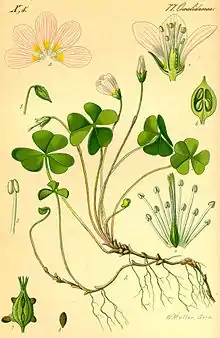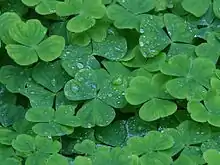Oxalis acetosella
Oxalis acetosella, the wood sorrel or common wood sorrel, is a rhizomatous flowering plant in the family Oxalidaceae, common in most of Europe and parts of Asia. The specific epithet acetosella refers to its sour taste. The common name wood sorrel is often used for other plants in the genus Oxalis. In much of its range it is the only member of its genus and hence simply known as "the" wood sorrel. While common wood sorrel may be used to differentiate it from most other species of Oxalis, in North America, Oxalis montana is also called common wood sorrel. It is also known as Alleluia because it blossoms between Easter and Pentecost, when the Psalms which end with Hallelujah are sung.
| Common wood sorrel | |
|---|---|
 | |
| Scientific classification | |
| Kingdom: | Plantae |
| Clade: | Tracheophytes |
| Clade: | Angiosperms |
| Clade: | Eudicots |
| Clade: | Rosids |
| Order: | Oxalidales |
| Family: | Oxalidaceae |
| Genus: | Oxalis |
| Species: | O. acetosella |
| Binomial name | |
| Oxalis acetosella | |

Description
The plant has trifoliate compound leaves, the leaflets heart-shaped and folded through the middle, that occur in groups of three on petioles up to 10 centimetres (3.9 in) long. It flowers from spring to midsummer with small white chasmogamous flowers with pink streaks. Red or violet flowers also occur rarely.[1]:116 During the night or when it rains the flowers close and the leaves fold.
As with other species of wood sorrel, the leaves are sometimes eaten. An oxalate called "sal acetosella" was formerly extracted from the plant, through boiling.

Anemone nemorosa (wood anemone) is similar. Both have white flowers, are small and are found in woody shady places. Anemone nemorosa however has palmately lobed leaves and does not have true petals but large sepals which are petal-like.[2]
Habitat
Woods and shady places in the northern hemisphere.[1]
Note
The common wood sorrel is sometimes referred to as a shamrock and given as a gift on St. Patrick's Day. This is due to its trifoliate clover-like leaf, and to early references to shamrock being eaten. Despite this, it is generally accepted that the plant described as shamrock is a species of clover, usually lesser clover (Trifolium dubium).
References
External links
| Wikimedia Commons has media related to Oxalis acetosella. |
- Den virtuella floran: Oxalis acetosella (in Swedish)
- Giftpflanzen.com — Waldsauerklee (in German)
- oxalis-acetosella.com — Oxalis acetosella (in German)